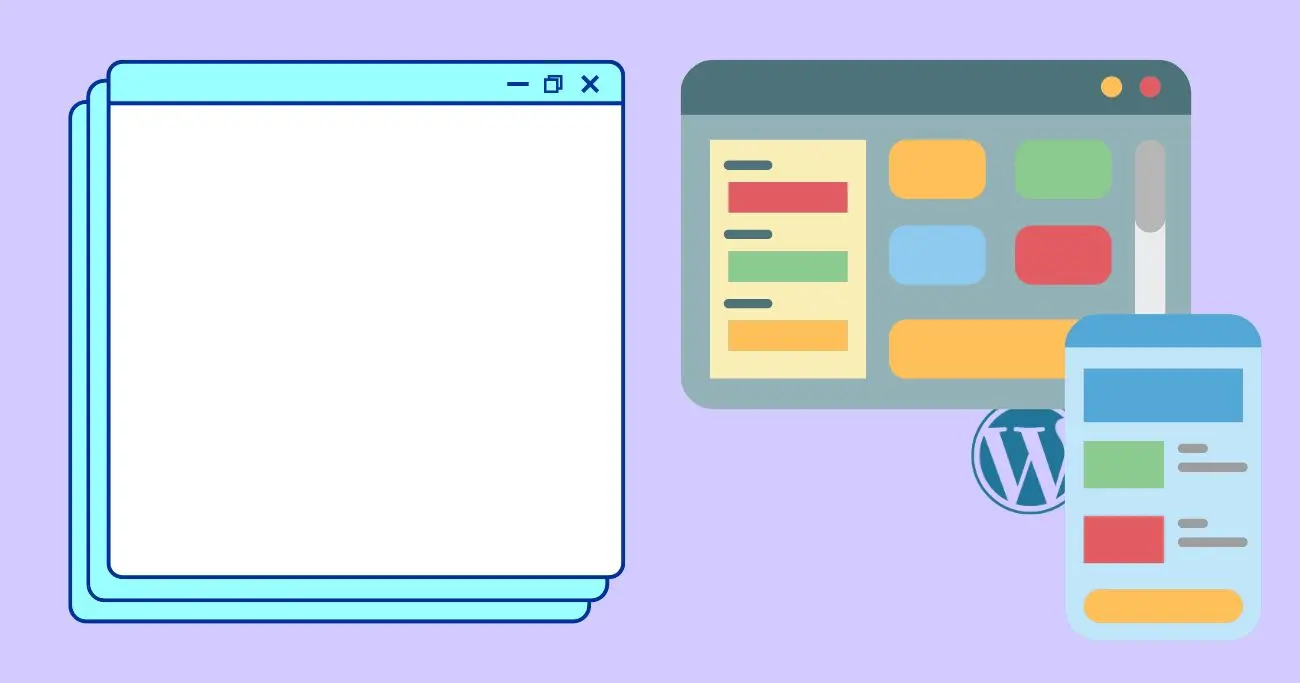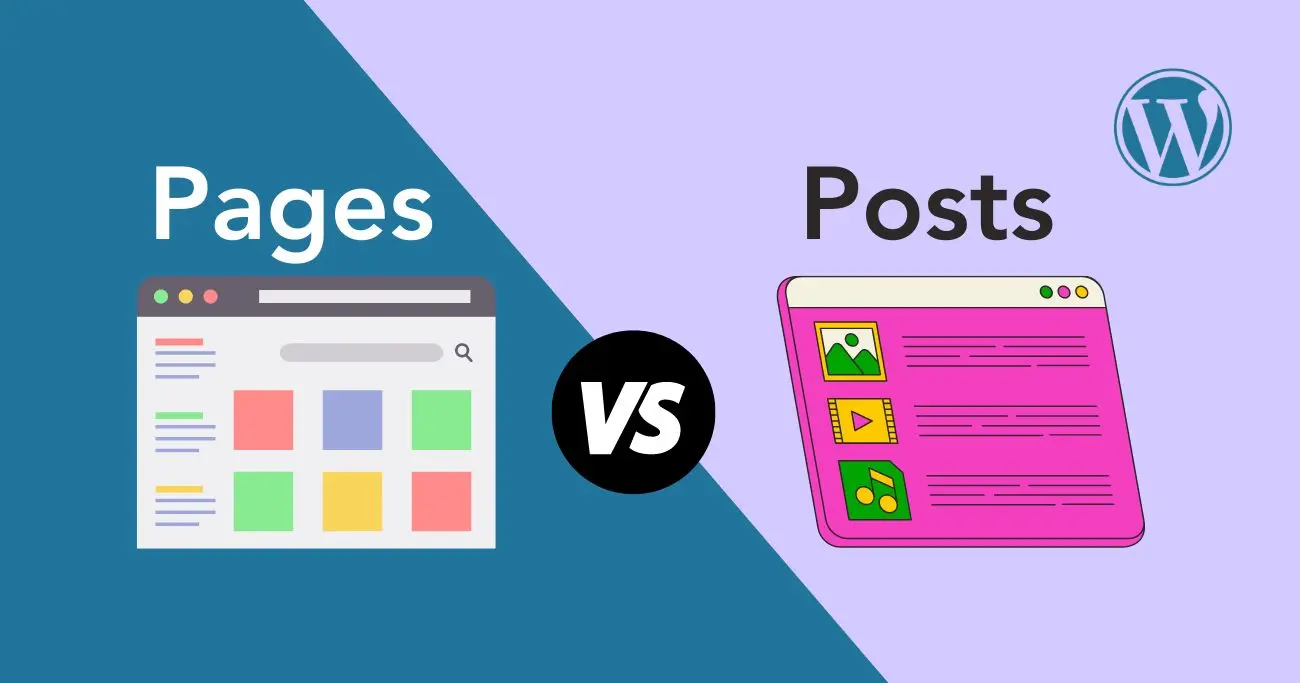Welcome to my guide on helping you understand the key differences between pages and posts in WordPress! As a beginner, this is one of the most fundamental things you need to learn about WordPress.
I’ll explain this concept in the simplest way possible with plenty of examples so even a child can understand it.
I’m going to walk you through this distinction in a way even a child could grasp. I’ll use simple real-world examples, and best practices from Google, and address common beginner FAQs.
My goal is to make you a WordPress expert by the end of this guide!
What Exactly is a Page in WordPress?

When people think of a “page”, they usually imagine a page in a book or magazine – one single piece of content touching on a specific topic.
A page in WordPress.com and WordPress.org works the same way.
A WordPress page is a single piece of content focusing on one particular subject. For example:
- About Us
- Contact Information
- List of Services Offered
- Company History
Pages are often described as static content because they rarely change over time. They have a fixed URL and do not change over time. For example: yourwebsite.com/about
Core Elements of a High-Quality Page
Once you publish your About Us page for example, you may not need to update it for months or years down the road.
Now what exactly makes for an effective page?
Here are 3 key elements that go into publishing reader-friendly WordPress pages:
1. Descriptive, Keyword-Rich Title
Every great page starts with a title optimized for both readers and search engines.
For example, a title like “Company History” tells visitors what the page is about while also using a relevant keyword.
Pro Tip: Keep your page titles below 70 characters so they don’t get cut off in search results.
2. Engaging Content
You need useful content to inform, educate or entertain your audience. Think about what visitors want to know and address those needs.
For a Services page, describe what you offer in a way that showcases value. Use lists, images, videos and facts to develop engaging content.
3. Clear Page Structure
Use reader-friendly formatting so people can easily scan and digest your content.
Break up paragraphs with section headers and lists. Use bold or italics to emphasize key points. Quality page structure improves the reader experience.
Now that you know what goes into an effective page, when should you use them?
Situations Where Pages Work Best
Here are some common use cases perfectly suited for WordPress pages:
- About Us – Tell your story and connect with customers.
- Contact – Share phone, email, social media links or a contact form.
- Services/Products – Showcase what you offer new visitors.
- Company History – Share your roots and accomplishments over time.
- Privacy Policy – Explain what data you collect and how it’s handled.
- Shipping & Returns – Describe how online orders and returns are handled.
- Team Bios – Introduce who makes up your company.
- Case Studies – Demonstrate success stories with individual pages.
As you can see, pages work very well for long-form evergreen content rarely needing updates.
Now let’s contrast this against…
What Exactly is a Post in WordPress?

If pages are static, think of posts as dynamic content constantly changing over time.
While a page focuses on one topic alone, a post is:
- A single piece of content also touching one subject at a time
- Displayed together with other posts in reverse chronological order
For example, a typical blog page will showcase posts in the following way:
- 20 Most Popular Dog Breeds in 2023 (Newest Post)
- 10 Tips for Caring for an Elderly Dog
- How Often Should You Bathe Your Dog?
As new posts get added over time, the older ones get pushed down automatically.
This ordering from newest to oldest makes it easy for readers to see your latest updates right at the top.
Now what exactly makes an engaging post?
Core Elements of Reader-Friendly Posts
Similar to pages, excellent WordPress posts also incorporate these 3 elements:
1. Descriptive, Keyword-Rich Title
Well-written titles quickly communicate the topic of a post while boosting SEO. You have full control over SEO on both pages and posts in WordPress. You can edit titles, meta descriptions, use target keywords, and much more to optimize each piece of content as recommended by Google.
2. Captivating Post Content
Share useful information readers actually want. Mix up paragraphs, lists, images and videos to develop an engaging post.
3. Scannable Layout
Break up long blocks of text for easy scanning with section headers and lists. Bold key points. Quality formatting improves readability.
Now when should you publish blog posts and news updates?
Situations Perfect for Posts & Updates
Here are some examples of effective uses cases:
- Blog – Provide tips, advice and commentary with regular blog posts to engage visitors.
- Industry News – Comment on recent developments related to your business.
- Product Updates – Announce new offerings, features and improvements.
- Thought Leadership – Establish expertise and credibility by teaching through posts.
- Movement Building – Rally people behind a cause or social issue with call to action posts.
- Reviews – Assess and critique books, movies, products or services of interest.
As you can see, posts allow you to build dynamic content over time – unlike more fixed pages.
Now that you understand the purpose of both, let’s clearly contrast some major differences between the two…
5 Key Differences Between Pages and Posts

While pages and posts share some core elements, they vary across 5 major factors:
1. Topic Focus
- Pages zero in on a single static topic (About Us)
- Posts revolve around ever-changing topics over time
For example, your About Us page content will rarely need updating year after year.
But blog posts will continuously cover new topics as they get published chronologically.
2. URL Structure
- Page URLs stay the same forever once published (yoursite.com/about-us)
- Post URLs include the publish date so they change with every new one (yoursite.com/2023/12/popular-dog-breeds)
So page URLs tend to be simpler while post URLs get longer and more complex over time. You can also change the URL structure of all the posts by setting the permalinks.
Speaking of URL structure, one key WordPress concept related to pages and posts is permalinks.
In simple terms, permalinks refer to the persistent URLs for all your content.
By default, WordPress assigns messy permalink structures like:
yoursite.com/?p=123
Luckily, you can customize permalinks to be more user and SEO-friendly, like:
yoursite.com/sample-post/
You control permalinks in your WordPress dashboard under Settings > Permalinks. I suggest keeping them short and simple.
3. Updating Frequency
- Pages rarely need changes once finished
- Posts get updated continually with new publishes
For example, you may update your Contact page once when your phone number changes.
But you’ll continually publish new blog posts every week or several times per month.
4. Display Order
- Pages appear based on a manual menu structure
- Posts automatically show the newest first in reverse chronological order
So you control page order but posts always place newest content right at the top.
5. Reader Expectations
- When visiting pages, readers expect fixed evergreen content
- When visiting posts, readers expect dynamic new information
For example, readers expect your Contact page to be relatively static with available information to get in touch.
But when they visit your blog, they want to instantly see your latest thinking on topics rather than outdated posts.
Let’s recap these 5 major differences:
- Topic focus
- URL structure
- Updating frequency
- Display order
- Reader expectations
Understanding these contrasts is key for structuring information effectively on your WordPress site.
Now let’s tackle some common beginner questions…
Frequently Asked Questions
Still fuzzy on some aspects of WordPress pages vs posts? Here are answers to 6 common beginner questions:
1. Can I add multimedia to pages and posts?
Yes! You can seamlessly embed images, YouTube videos, podcasts, diagrams, and much more on both pages and posts. No limits on multimedia capabilities.
2. What exactly are landing pages? Pages or posts?
Many WordPress themes support special landing page templates mapped to the Pages menu. So technically, landing pages operate just like standalone WordPress pages due to their fixed nature once published. You just have to pick the supported theme for your WordPress website.
3. Can I schedule future publishing?
Definitely! With WordPress, you can specify a future date and time for both pages and posts to be published automatically. Very handy for batching up content creation well in advance.
4. What’s better for SEO – pages or posts?
Generally speaking, pages may offer slightly higher SEO value in the long run:
- Page URLs never change while posts change over time
- Pages remain online indefinitely while old posts eventually get archived
- Pages tend to use more searcher-targeted keywords
However, regular new blog posts are also crucial for SEO by continuously adding fresh content to your site.
So focus on quality content above all else, then leverage pages and posts for maximum search visibility.
5. Where do I actually manage pages and posts within WordPress?
Excellent question! Here’s where you access everything:
- Login to your WP dashboard and look in the left sidebar
- You’ll see menu items for “Pages” and “Posts”
- This is where you create, organize, and manage all your content
Click those items to get started publishing!
6. Can I optimize individual pieces of content for search ranking?
Absolutely! With WordPress, you have complete flexibility to customize titles, target keywords and layouts page-by-page and post-by-post. This allows precise SEO optimization for every piece of content you publish independently.
Let me know if you have any other questions!
Final Thoughts
Understanding the difference between pages and posts is WordPress 101.
To quickly recap:
- Pages = Timeless evergreen content rarely needing updates
- Posts = Frequently updated dynamic content displayed the newest first
Key differences:
- Topic focus
- URL structure
- Updating frequency
- Display order
- Reader expectations
Hopefully, this beginner’s guide clarified the unique value and best use cases for both pages and posts in WordPress.
Now you’re ready to effectively publish content optimized for your goals!
Hopefully, this beginner’s guide has clearly explained these core concepts to you! You can also check out the WordPress blog about the Difference between Pages and Posts here.

